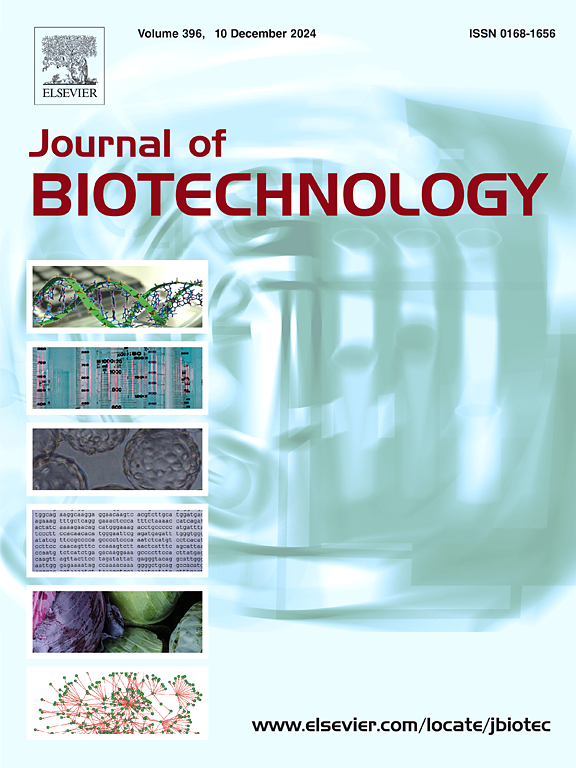Microbial production of single cell oil from biowaste-derived volatile fatty acids using a newly identified oleaginous Cyberlindnera jadinii
IF 3.9
2区 生物学
Q2 BIOTECHNOLOGY & APPLIED MICROBIOLOGY
引用次数: 0
Abstract
Efforts to achieve a circular economy emphasize waste minimization while maximizing its value through recycling and reuse. Volatile Fatty Acids (VFAs), derived from organic waste streams, hold biotechnological potential as raw materials for producing value-added compounds offering sustainable alternatives to traditional petroleum-based approaches. The phenotypic and genomic plasticity of non-Saccharomyces yeasts positions them as ideal candidates for VFAs metabolization. In this study, the growth profiles of 48 yeasts were assessed using seven VFAs as sole carbon sources, as representative of a real organic waste stream composition. Growth was assessed individually and in mixtures of the VFAs, at concentrations representative of the organic biowastes. Using AMiGA tool we deepened yeasts growth dynamics based on the optical density growth curves measurements. Ten isolates showcased superior performance, through their varied growth under different VFAs combinations. Acetic and isobutyric acids were the most favourable VFAs for non-Saccharomyces yeasts growth, balancing efficiency and adaptability. In contrast, butyric and caproic acids were the less effective, likely due to metabolic constraints or inhibitory effects. Yeasts favoured lipid synthesis over TCA intermediates, glycerol and ethanol. Two C. jadinii strains stood out as particularly interesting considering their metabolic plasticity, successfully assimilating both individual and combined VFAs, achieving the highest growth coupled with a superior lipid production (19.5–26.7 % (w/w)). These findings establish C. jadinii as an oleaginous yeast, a trait firstly reported here, underscoring its promise as a cornerstone for biowaste valorisation.
利用新发现的产油油料的jadinii cyberlinnera从生物废物衍生的挥发性脂肪酸中提取单细胞油的微生物生产。
实现循环经济的努力强调废物最小化,同时通过回收和再利用使其价值最大化。挥发性脂肪酸(VFAs)来源于有机废物流,作为生产增值化合物的原料具有生物技术潜力,为传统的石油基方法提供了可持续的替代品。非酵母菌的表型和基因组可塑性使它们成为VFAs代谢的理想候选者。在本研究中,以7种VFAs作为唯一的碳源,作为真实有机废物流组成的代表,对48种酵母的生长曲线进行了评估。分别评估了生长情况,并在代表有机生物废物浓度的vfa混合物中评估了生长情况。利用AMiGA工具,在测量光密度生长曲线的基础上加深了酵母的生长动态。10株菌株在不同VFAs组合下的生长情况不同,表现出优异的生长性能。乙酸和异丁酸是最有利于非酵母菌生长、平衡效率和适应性的VFAs。相比之下,丁酸和己酸的效果较差,可能是由于代谢限制或抑制作用。酵母较TCA中间体、甘油和乙醇更倾向于脂质合成。考虑到它们的代谢可塑性,两个jadinii菌株特别有趣,它们成功地同化了单个和组合的VFAs,实现了最高的生长和优异的脂质产量(19.5%至26.7% (w/w))。这些发现证实了C. jadinii是一种产油酵母,这是本文首次报道的一种特性,强调了它作为生物废物增殖的基石的前景。
本文章由计算机程序翻译,如有差异,请以英文原文为准。
求助全文
约1分钟内获得全文
求助全文
来源期刊

Journal of biotechnology
工程技术-生物工程与应用微生物
CiteScore
8.90
自引率
2.40%
发文量
190
审稿时长
45 days
期刊介绍:
The Journal of Biotechnology has an open access mirror journal, the Journal of Biotechnology: X, sharing the same aims and scope, editorial team, submission system and rigorous peer review.
The Journal provides a medium for the rapid publication of both full-length articles and short communications on novel and innovative aspects of biotechnology. The Journal will accept papers ranging from genetic or molecular biological positions to those covering biochemical, chemical or bioprocess engineering aspects as well as computer application of new software concepts, provided that in each case the material is directly relevant to biotechnological systems. Papers presenting information of a multidisciplinary nature that would not be suitable for publication in a journal devoted to a single discipline, are particularly welcome.
 求助内容:
求助内容: 应助结果提醒方式:
应助结果提醒方式:


